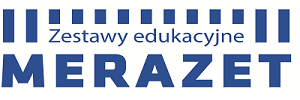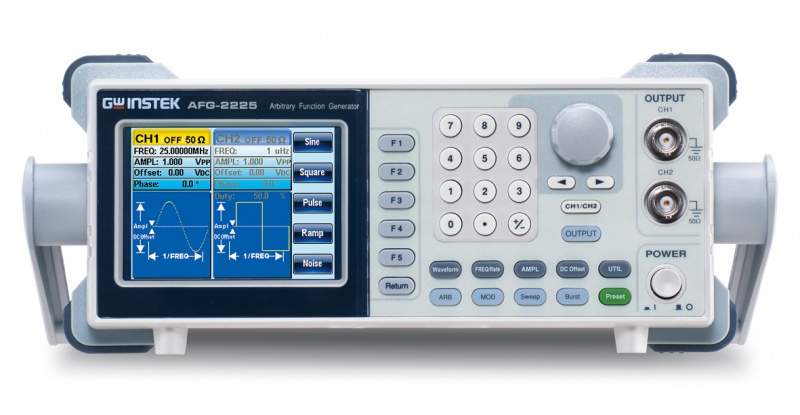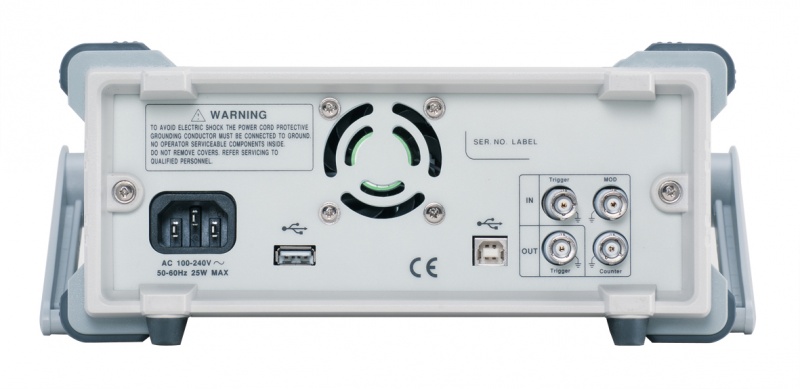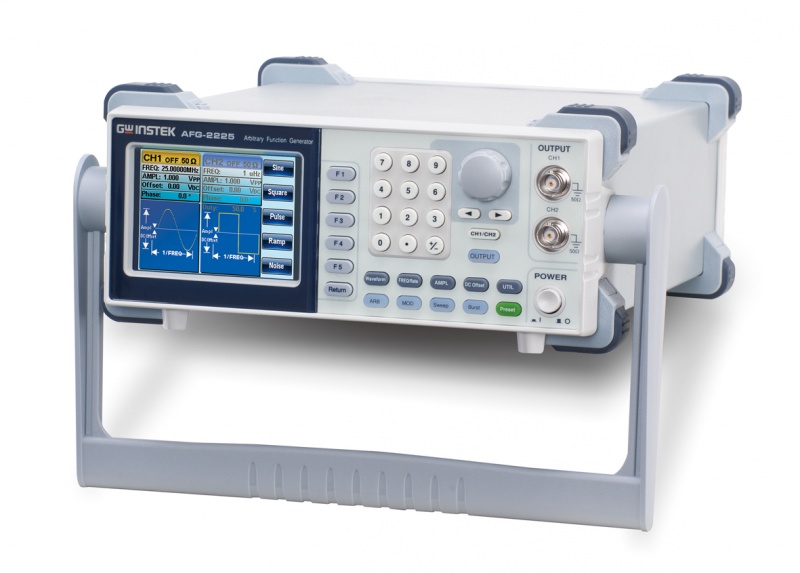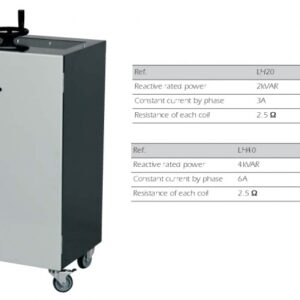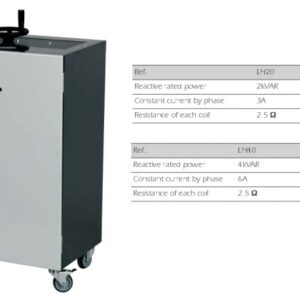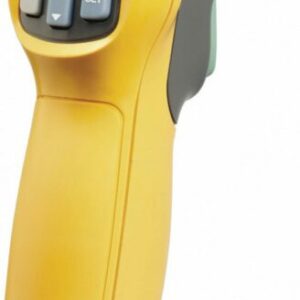Opis
- Wide Frequency Ranges From 1μHz to 25MHz (sine/square wave)
- 1 μHz Resolution in Full Range
- Built-in Standard 120MSa/s, 10bit, 4k Points Arbitrary Waveform for Both Channels
- True Dual-Channel Output, CH2 Provides the Same Characteristics as CH1
- Couple, Tracking, Phase Operations of Dual Channel are Supported
- 1% ~ 99% Adjustable Duty Cycle for Square Waveform
- High Resolution and Colored TFT LCD with Friendly User Interface
- Multiple Editing methods to Edit Arbitrary Waveform Easily
- Built-in Standard AM/FM/PM/FSK/SUM/Sweep/Burst and Frequency Counter
- USB Host/Device Interface for Remote Control and Waveform Editing
GW Instek is launching AFG-2225, its first basic level dual-channel arbitrary function generator, which provides superior features in its class. Both channels are equipped with same characteristics to fit dual-signal applications such as differential or IQ signaling. The outstanding cost-performance value makes the AFG-2225 a practical instrument to accelerate the development process.
The major features for both channels include 10Vpp output amplitude; 25MHz frequency bandwidth with 1uHz resolution; built-in waveforms of Sine, Square, Ramp (Triangle) and Noise. As to the 1%~99% adjustable duty cycle of Square waveform can be used as pulse signal sources. For the arbitrary waveform, user can edit the 66 built-in waveforms or create a whole new one. Moreover, AFG-2225 carries features of AM/FM/PM/FSK/SUM Modulation, Sweep, Burst and Frequency Counter, which can be applied to various communication fields.
In addition to the intuitive and friendly user interface, the 3.5-inch color LCD displays the comprehensive operation information including the true waveform presented at the output. USB Host and Device interfaces are equipped to link the AFG-2225 with other devices, which provide the flexibility of waveform generation for more practical usages. With link to GW Instek GDS-series Digital Storage Oscilloscopes (DSOs), the waveforms of interest can be captured and reconstructed. User can also use the arbitrary waveform PC software to edit the waveform and then send to AFG-2225 directly, or save the waveform into flash drive and then transfer to AFG-2225.
-
Frequency ranges from 1uHz to 25MHz, and offers multiple standard waveforms
AFG-2225 offers signal output by DDS technique. The maximum frequency is 25 MHz and offers full-range 1uHz frequency resolution. The built-in functions include Sine, Square, Ramp/Triangle, Pulse, and Noise. 
Wide Frequency Range -
Full-Functions equipped Dual-channel Signal Output Capability
In most two-channel signals applications, such as digital modulation and vehicle electronic simulation signals, the similar or identical waveform capabilities are required for both channel outputs. Unlike other dual-channel AFG in this class, AFG-2225 is fully equipped with equal capabilities on dual outputs. Most of dual-channel arbitrary waveform generators in this basic level cluster offer one major channel and one minor channel, in which the minor channel only provides less functions or inferior performances. This sort of non-full-function dual-channel AFGs can not meet the requirements of reality. 
The equivalent function in dual-channel -
Correlated Functions of Dual-channel Outputs
The two channels can be used in either independent or correlated configuration. AFG-2225 provides three correlated functions which are Couple, Tracking and Phase functions. For Couple function, two signals with a ratio or offset in amplitude or frequency can be generated. One of two signals with adjustable offset frequency is an example which can form the two-tone signals for testing the third order inter-modulation distortion of an amplifier. With Tracking function, two differential signals with equal-frequency, equal-amplitude but inverted phase can be produced. Examples such as PECL, LVPECL and LVDS digital signals or automotive sensors like temperature, speed signals are all able to be simulated by tracking function. The Phase function is designed to create two signals with specified phase offset. When user wants to create two quadrature (sine and cosine) signals, the phase offset is set to be 90 degrees in the Phase function. In conclusion, compared with other arbitrary function generators only equipped with phase function, AFG-2225 provides great convenience to fulfill the various challenges coming from modern electronic industries. 
Coupling in dual-channel Operation
Differential Signals
Quadrature (sine and cosine) signals -
High-flexibility of Arbitrary Waveforms Editing
AFG-2225 provides 120MSa/s sampling rate, 10-bit vertical resolution, 4k-point waveform length, and the maximum waveform repeated rate of 60MHz, regarded as an outstanding arbitrary waveform capability. There are four ways for AFG-2225 to generate customized arbitrary waveforms, which are editing waveform via PC software, point-by-point editing on the panel, loading CSV file and loading the captured waveform from GW Instek GDS-Series Oscilloscopes.The PC software editing and point-by-point editing particularly provide the way to create the user-defined and post-modification waveform. CSV file loading capability allows AFG-2225 to produce the waveforms with complicated math operation result. For example the MSK (minimum shift keying) signaling in digital communication system needs integral operation. Engineer can use PC math software to process the integral and then send the results in CSV format to AFG-2225. With the link to GW Instek GDS-series Digital Storage Oscilloscopes (DSOs), the waveforms of interest can be captured by DSO and then reconstructed by AFG-2225. User can capture the waveform during the operation and then reconstructed by AFG-2225 for further analysis or diagnosis in the laboratory. Thus, plus the dual-channel feature, numerous derivative applications of capturing signal can be achieved. 

Front Panel Operation Supports CSV file upload 

Direct Waveform Reconstruction (DWR) Capability Arbitrary Waveform Editing PC Software -
1%~99% Adjustable Duty Cycle of Square Wave
Inheriting the advantage of AFG-2000 Series, AFG-2225 provides a 1%~99% variable duty cycle for its Square waveform within 100kHz bandwidth, which is considered practical for the tests such as simulating pulse and transient signals without purchasing extra advanced function generator and pulse generator. 
-
Friendly Operating Interfaces and Instant Parameter Display
AFG-2225 provides friendly panel operation setting as well as what You See Is What You Get operating way. From editing to output, the process can be manipulated via panel. Besides equipped with highly-flexible editing method, the immediate diagram is capable for users to understand the current waveform status and the output waveform contents under the storage/output setup. 
More flexibility of arbitrary waveform storage and extraction -
66 Built-in Arbitrary Waveforms
66 frequently used function waveforms in all fields are built in arbitrary waveform memory for user’s selection. They are categorized into four groups, Common, Math, Window and Engineer. The trigonometric derivative functions, Blackman, Chebyshev, Bessel, Gamma, Gauss … can be selected and developed by further editing. 
66 kinds of waveforms in 4 catalog -
Support Multi-change Signal Application
AFG-2225 owns built-in functions, such as Modulation, Sweep, Burst, and RF Counter. The modulation waveforms contain AM, FM, PM, FSK, SUM, and either an internal signal or an external signal can be selected to perform the modulation. Sweep Function includes two sweep ways, linear and log mode, which can also perform sweep function in internal or external. Burst function supports two modes, Gate and N-Cycle, which can be used to control parameters such as phase angles, duration frequency, and duration time. The built-in Frequency Counter is available to provide the maximum 150MHz frequency range without additional purchase. 
FSK Modulation, Sweep, and Burst Function
-
Impedance Switch Function
Majority of users are using oscilloscope to observe the waveforms of function generators. However, the differences of input impedance of function generators and oscilloscopes are not the same, and the oscilloscope will not necessarily be equipped with built-in input impedance switch function; the correct amplifier can only be received through computing. AFG-2225 provides 50Ω and high-input impedance switching modes, which can efficiently enhance the accuracy while users reading the results.  50Ω/High Z Impedance Switch Function
50Ω/High Z Impedance Switch Function -
Provide USB Host/Device Interface
The USB Host/Device Interfaces are located at the rear panel of AFG-2225. The USB Host is mainly used for directly reconstruction of waveforms of GW Instek GDS-Series Oscilloscope, thus, it can be stored and recalled at portable USB Flash Drive; as to USB Device, which is used to connecting with PC, besides controlling through software on PC, USB Device also supports IEEE488.2 Command List for users to process customized functional control. 
USB Host & USB Device
